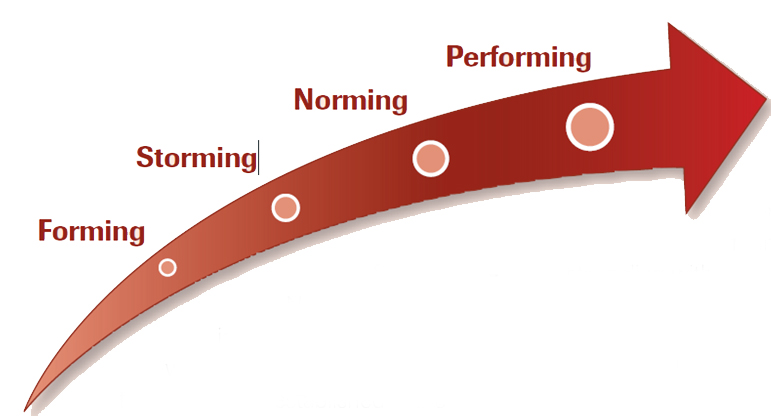 Forming – In this stage, team members first come together. They are positive and polite. Some are anxious, as they haven't fully understood what their role will be and how the team will work. As leader, you play a dominant role at this stage, because team members’ roles and responsibilities aren’t clear. This stage can last for some time, as people start to work together, and as they make an effort to get to know their new colleagues.
Forming – In this stage, team members first come together. They are positive and polite. Some are anxious, as they haven't fully understood what their role will be and how the team will work. As leader, you play a dominant role at this stage, because team members’ roles and responsibilities aren’t clear. This stage can last for some time, as people start to work together, and as they make an effort to get to know their new colleagues.
Storming – Next, the team moves into the storming phase, where people start to push against the boundaries established in the forming stage. This is the stage where many teams fail. Storming often starts where there is a conflict between team members’ natural working styles. People may work in different ways for all sorts of reasons, but if differing working styles cause unforeseen problems, they may become frustrated.
Storming can also happen in other situations. For example, team members may challenge your authority, or jockey for position as their roles are clarified. In addition, if you haven't defined clearly how the team will work, people may feel overwhelmed by their workload, or could be uncomfortable with the approach you’re using.
If you watch BBC’s The Apprentice, you will see these two stages most weeks as the teams initially come together, then to varying degrees either fall apart or progress to the next stage of development.
Norming – Gradually, the team moves into the norming stage. This is when people start to resolve their differences, appreciate colleagues’ strengths, and respect your authority as a leader. Now that your team members know one another better, they may socialise together, and they are able to ask each other for help and provide constructive feedback. People develop a stronger commitment to the team goal, and you start to see good progress towards it.
Performing – The team reaches the performing stage when hard work leads, without friction, to the achievement of the team’s goal. The structures and processes that you have set up support this well. As leader, you can delegate more of your work, and you can concentrate on developing team members.
It feels easy to be part of the team at this stage, and people who join or leave won’t disrupt performance.
We will return to Tuckman’s model later, as we describe how to use it to ensure that your team passes through the earlier, less productive phases of team development, as quickly as possible.
Never has it been more important to build a strong and motivated team that it is a pleasure to be a part of. Increasing prescription volumes, new services and enhanced customer and patient expectations can be challenging, but by having a good team around you it becomes much easier to manage, much more resilient when faced with the unexpected, and much higher performing.
Teams that are highly motivated and positive are not only fun to be part of, but they also accomplish far more than teams that are struggling with morale. This is why it's so important that, as a leader, you strive to build a positive team. In the next section of the module, we will explain how.
